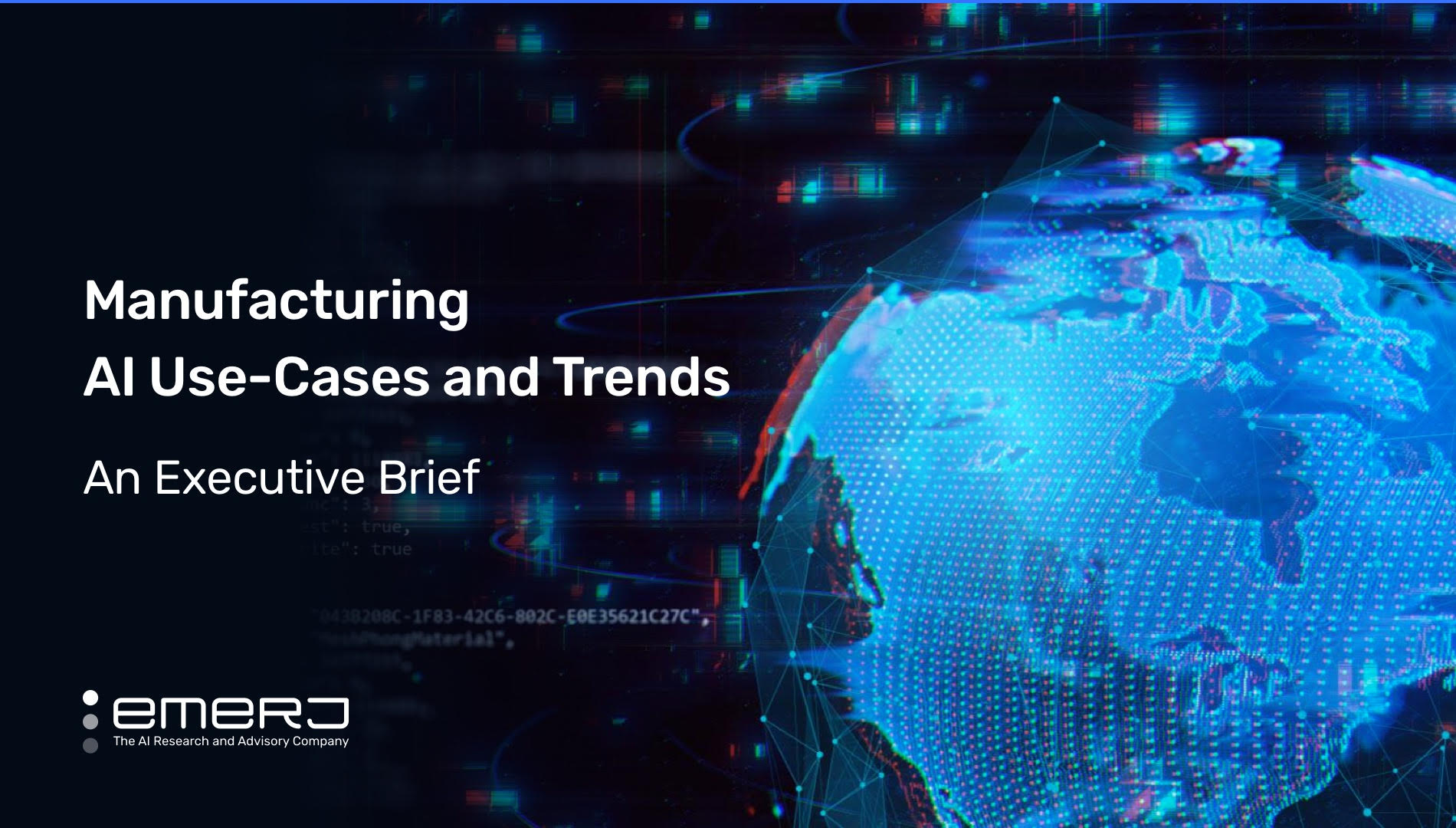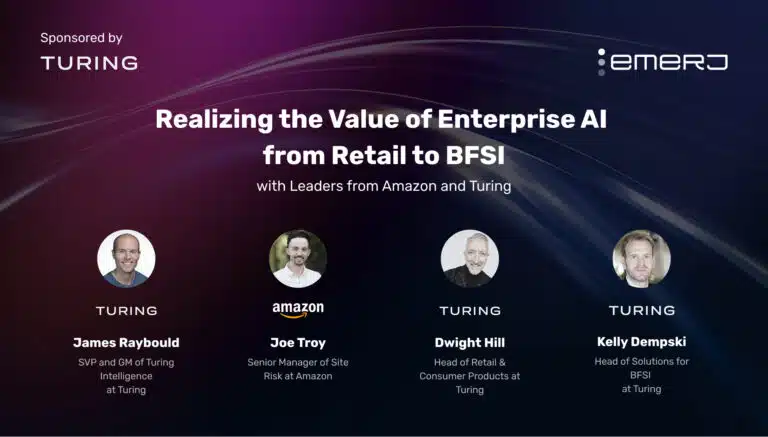Almost no other sector is traditionally slower to technological adoption than manufacturing, in no small part due to the countless challenges of relying on data accrued from physical environments. Yet across industries, manufacturing business leaders are finding that data is finally “waking up” to the nuances and fundamentals of their business operations.
That awakening is fueling a slow-burning manufacturing resurgence in the US and, added to the breakdown of supply chains in the wake of COVID-19, industrial business leaders are feeling the pressure to compete.
According to a recent report from Gartner, 36% of CIOs at heavy manufacturers who reported a recent disruption in their industry said their operating cost competitiveness was falling behind. In another assessment from Accenture, 95% of industrial equipment executives think the industry is facing at least moderate disruption – with 21% attesting to “complete” disruption in their sector.
In short, manufacturers are considering AI capabilities at a time when they can barely keep up with the present. Last year, economists projected that AI spending in manufacturing could reach $11 billion by 2025. Given the circumstances, we at Emerj are observing two major trends currently driving the early stages of AI adoption in manufacturing:
- Data is waking up
- Supply chains are still recovering from COVID-19
In turn, these trends are producing insightful AI adoption use cases in the following areas:
- Predictive Maintenance
- Improving Quality and Throughput
- Inventory Prediction
To give manufacturing leaders a clear perspective on these congruent technological and economic sea changes fueling AI investment in manufacturing, Emerj offers the following executive brief so those leaders can make informed decisions about adoption as they are relevant to the facts and circumstances of their business.
AI Adoption Trends in Manufacturing
Let’s begin by taking a closer look at these trends and why we think they will continue to drive the manufacturing investment in AI solutions:
Data is Waking Up
There are two types of data that are most important to manufacturers: machine data and sensor data. Machine data in a manufacturing context generally refers to data taken from machines that are usually built before 1980, thus not made for the Digital Era.
Gathering data from physical environments not designed with data gathering in mind always makes for time-consuming business challenges leading to imperfect solutions. Usually, such machines in continued use today are slow, bulky, and only remain in use to save money on a replacement in many cases.
Meanwhile, strides in sensor technology over the last decade from smartphones are making sensors more versatile and cost-effective for application to older machinery. As IBM’s VP of Product Joe Berti recently explained on Emerj’s AI in Business podcast, sensors in 2022 are better able to offer tailor-made data gathering solutions for machinery and infrastructure not designed with data gathering in mind:
“There’s now a whole class of what I call ‘Fitbit for machine.’ So everybody knows what a Fitbit is. You wear them on your wrist and track your steps. And then I know your heart rate data and other things. So there are now these ‘Fitbit for machines’ where you can take an old piece of equipment, and actually retrofit them – I think they look like hockey pucks. They sometimes have 7, 10.. 12 sensors in them… And you have a magnet on it and you put it on the side of the machine. And then all of a sudden, you now have sensors on a machine that didn’t have sensors before. That being said, you have to put it on the right equipment, you just putting sensors on anything doesn’t make sense.”
By blending machine and sensor data from both the inside and exterior of machines, factories are just beginning to find themselves interwoven in the “internet of things.” These integrations mean greater insight into forecasting problems: manufacturers have a better idea of when and how their machines break down, and from those insights, determine how best to push their outputs to capacity.
In a recent episode of Emerj’s AI in Business podcast, Chief Scientist for Artificial Intelligence at GE Global Research Peter Tu explained the challenges emerging from the influx of censor data taken from entire factory facilities:
“Where I think the big challenge here is that we’re looking at the factory itself: there’s n number of sensors, n number of complex processes going on these things… And we’ve coined terms in other people using this with things like ‘digital twins’: How we model these relatively complex systems, in order to understand these ‘digital twins’, may [have] more to do with the part or the device, but it can also be viewed as at the factory level as well. Here the problem tends to be AI thrives on data – meaning I have 10,000 million samples of this particular dataset. And I’ve learned over time, statistically, how do these x’s map to these y’s?
The problem with looking at factories is that to some extent, they’re like snowflakes. You may have learned a lot about a factory in Minnesota – those learnings, those samples, that data, that knowledge may only have somewhat relevance to a similar factory in another state for various reasons.”
Supply Chains Are Still in Shock from COVID-19
In the wake of a global pandemic, the need for manufacturers to predict supply and demand is higher than ever. There is no shortage of reports from across the global economy of inventory sitting in warehouses. For manufacturers, idle inventory is often unusable and unsellable because they are missing critical pieces that are also sitting idle in another warehouse halfway across the world.
The damage is much more severe as compared to idle freight sitting in warehouses since extra inventory in retail usually can be recycled into sales revenue somehow. Freight itself is an industry still reliant on the old, far less reliable world of written ledgers and paper receipts – leading to a wave of startups like Flexport promising to fix these problems.
Most Popular Use Cases in Manufacturing
In 2022, manufacturers are finding the promise of AI extends beyond predictability and into improving quality and throughput throughout the assembly line. In the section below, here are what Emerj believes to be the most popular current use-cases of AI in manufacturing today:
Predictive Maintenance
The enemy of all manufacturing operations is a breakdown (or “unexpected downtime” as it’s referred to in heavy industry). In so many words, breakdown means unplanned downtime, either from broken machines, late supplies, personnel issues, or any manner of factory-related issues. We’ll come back to the concept again when we discuss maximizing uptime.
To address unplanned downtime, the first tool in a manufacturer’s business arsenal is a concept called predictive maintenance, and one particularly conducive to the advantages of AI adoption.
Traditionally, the practice of predictive maintenance means human actors running from emergency to emergency, trying to fix problems as fast as they can and accepting the occasional breakdown as inevitable. Manufacturers are now beginning to realize a future where censors can collect historical data with enough depth to forecast, and ultimately avoid, breakdowns.
Being able to predict breakdowns in factory machinery and infrastructure with such painstaking accuracy is also extending firms’ abilities to guarantee product quality outside the factory as well. If Boeing is collecting enough censor and machine data to know exactly when the machines that make their jet engines will break down, they can make more accurate predictions about that jet engine’s longevity and functionality in the field.
Improving Quality and Throughput
All manufacturing operations are measured to some degree by product quality. Inevitably, a certain amount of product will not leave the assembly line correctly or even in a sellable state. In turn, manufacturers are always asking “How many products can be put through the assembly line without harming overall quality?”
If a car manufacturer is seeing warped steering wheels at the end of their assembly line, one of their machines might be overheating. Whatever the diagnosis, they’ll be making determinations based on censor, streaming, and particularly visual data to help answer that question.
The next question for manufacturers that AI can help answer in regards to quality and throughput is, “How can we maximize uptime without breaking our machines?” After all, the machine is still costing the manufacturer whether it works or not.
Inventory Prediction
While Emerj estimates that over 60% of manufacturing investment in AI is for the end of improving predictive maintenance, quality and throughput, the remaining areas of investment are indicative of changing strategies and priorities throughout the sector.
Thanks to AI, what ‘happens outside the factory’ is no longer a passing thought for those responsible for the inside. In fact, manufacturers are looking for any external data points they can gather – about their vendors, supply chain, purchases, and inventory levels over time – that will let them estimate their inventory levels a month from now.
We spoke to Caroline Gorski, Group Director of R2 Data Labs at Rolls Royce, about these data points on Emerj’s AI in Business podcast. When asked about the form they can take in concrete use cases she sees at Rolls Royce, Gorski told us that much of the communication between the luxury automotive company’s suppliers is through two dimensional drawings that are into 3D geometric data for engineering purposes.
In one example relevant to inventory prediction, that 3D geometric data is used to judge how much waste material generates from producing a component, which the supplier of the content can reimburse and resell in a secondary market:
“So for us to understand, for example, how much is something going to weigh; how much is it, therefore, going to cost to ship and transport; [or] how much rebate should we be getting from the waste material that’s been resold by the supplier on, [then] we need to be able to render a 2D drawing into its 3D geometry.”
These data points can be based on orders in the pipeline, sales that have not closed yet, seasonal variations of demand trends, and more. Seeing these variables holistically and historically through data analysis, manufacturers are beginning to predict how long it will take for components to arrive from a supplier with greater accuracy than ever before.
The business importance of being able to predict these variables, whether there is a global pandemic or not, cannot be overstated. If you do not know when components are arriving at your factory, that means perfectly working machines sit idle while hourly paid workers have nothing to do. In other words, what was once considered routine unplanned downtime can now be avoided.
Though the scenario of idle machines and workers is not ideal, it might still be preferable to machines breaking down or workers having to fulfill so many orders that quality suffers – if leaders are given the choice between them. Either way, the difference AI is making in this process is helping manufacturers find a medium between these two extremes and maintain that balance based on available data.
Challenges to AI Adoption in Manufacturing
Physical Data
As mentioned, Gathering data from the physical world remains the biggest challenge for manufacturers in AI adoption because it is the most unique to their industry. Where Amazon can track every pixel your cursor scrolls over to make a purchase, Target cannot replicate those capacities for customers searching their stories. Furthermore, no factory on Earth can get that much information about the workers, machines, and products in their factories through cameras and sensors.
Between visual data surveillance, crossing legal hurdles, and the effects on worker morale to name just a few incremental challenges, the road to clean, physical data is paved in high promise and lacking results. There might not be a better example of underwhelming results than PREDIX, General Electric’s ‘industrial IoT platform’ that was shuttered by management almost eight years after its conception in 2013.
Manufacturing is Slow to Technology Adoption
AI adoption in manufacturing in the last few years represents an exception to a very old and reliable rule: manufacturing reacts very slowly to technological changes. Even if manufacturers shared in Silicon Valley’s excitement for the latest and greatest advancements, that still doesn’t make data from the physical world any easier to gather.
To make a more apt comparison: legacy industries with as much history as manufacturing, like banking and insurance, can similarly feel like they are ‘stuck in the past’. Larger banks have at least some budget for digital transformation and are well beyond the use of yellow pads and snail mail to run operations.
Many manufacturing firms are running the same way they were in the ‘80s and often still using machines that date back to the Johnson administration. In comparison to even retail, finance or life sciences, our experience at Emerj leads us to believe that AI fluency in the manufacturing space couldn’t be lower.
However, that might also depend on what country you’re talking about: Many American firms aren’t as prepared for digital transformation as their German or Japanese peers. But no matter where you have operations, data coming from old machines augmented with new sensors will never be as ‘clean’ as manufacturers need it to be.
That isn’t stopping manufacturers from finding and producing data. Deloitte estimates that manufacturing is on track to generate roughly 1,812 petabytes (PB) of data every year – more than finance, retail, communications, and other industries.
What is Working
In taking a closer look at what manufacturing players are successful in adopting AI and why, two core lessons emerge from our analysis:
Engage Subject Matter Experts Early
All technology adoptions – AI or otherwise – need buy-in from the shop floor. AI in particular can present messaging problems for rank-and-file factory workers who might confuse AI with the kind of automation that puts them out of a job. It is important to find champions with AI familiarity – enough to know how much easier it can make life on the shop floor – and are thought of as leaders by their colleagues, regardless of title. This is important for two reasons:
- The job remains the same: Many jobs across the global economy have changed so drastically over the last century that their day-to-day tasks look nothing like they did 100 years ago, like marketing. That cannot be said of life on a factory floor, which gives subject matter experts in these areas tremendous influence when introducing intimidating technologies.
- AI and the human element: AI fluency is so important among these champions so they can express AI’s capacity for enhancing the innate talents and skills only human beings currently possess.
A recent podcast from McKinsey detailing shared reporting with MIT on successful AI use cases in manufacturing emphasized the importance of frontline training and paying careful consideration to the balance between human presence and machine capabilities for adoption to work. In particular, McKinsey Senior Partner Vijay D’Silva applauds McDonald’s for developing apps that track footfall and training their frontline staff in understanding the metric’s importance.
Project Selection
Project selection should be based on two primary questions:
- Where is the most uniform data coming from?
- Where can the biggest business impact be made?
In terms of predictive maintenance, the first question will follow from asking, “What machines are the most similar?” Similar machinery means uniform data, which means you want a high volume of identical inputs and outputs from which to take data. If you only have a few machines or many different kinds of machines, it will be difficult to collect data worth analyzing.
As for almost all other industries, similarity in fact might matter more than volume in this scenario, as instances of malfunctions and other rare occurrences will be the most valuable to track. Once you have machines and uniform data selected, the next question to ask is what data is going to help our bottom line?
If we’ve answered all questions effectively up until this point, ROI will be much easier to realize.



















